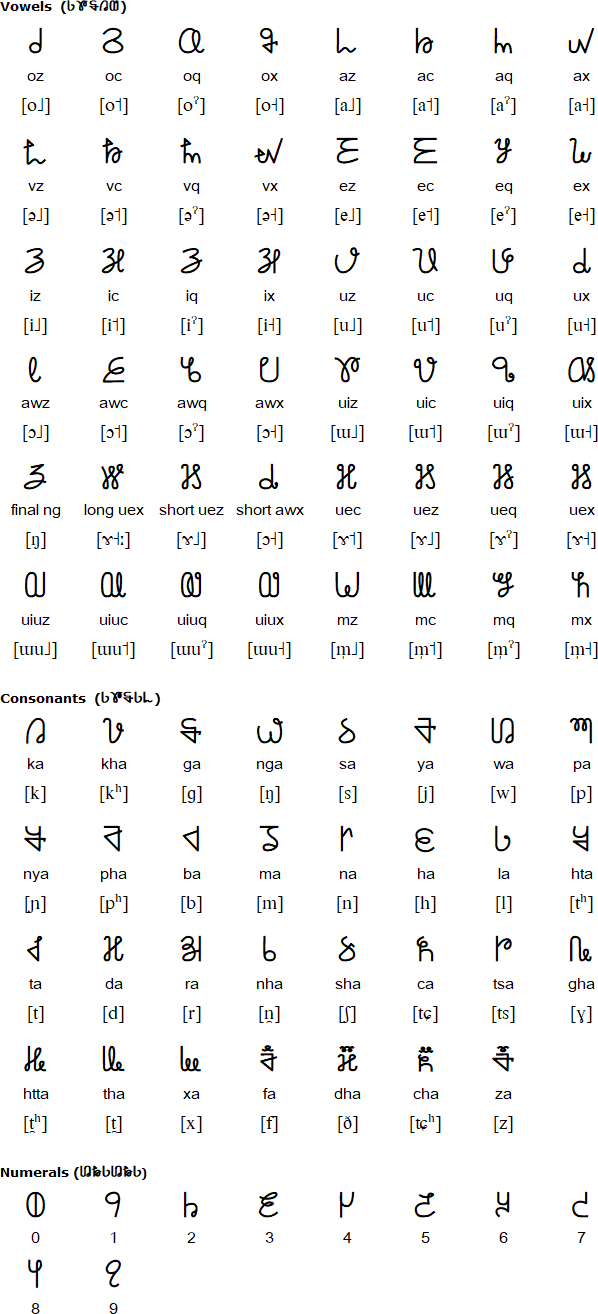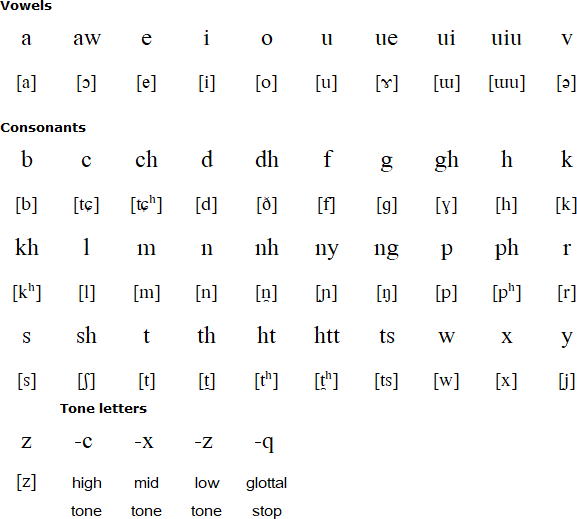The Tangsa alphabet was created in 1990 by Mr Lakhum Mossang from Namphai Nong in Arunachal Pradesh in northern India to write the Tangsa language. Tangsa is a member of the Brahmaputran branch of the Sino-Tibetan language family spoken in the Sagaing Region and Kachin State in northern Myanmar / Burma, and in the northern Indian states of Arunachal Pradesh and Assam.
Tangsa is a group of more or less mutually intelligible dialects of languages. It is also known as Tase or Tase Naga. The Tangsa alphabet is specifically designed to write the Mossang (Muishvung / Muixshvungx) dialect of Tangsa, the native dialect of Lakhum Mossang.
Lakhum Mossang, who died in 2020, taught the script public events and festivals, and worked with community organisations, local government and schools to promote the script. In 2021 there were about 100 people using the script, and material for teaching it are being produced.
There is also a way to write Tangsa with the Latin alphabet.


Download alphabet charts for Tangsa (Excel)

Details provided by Biswajit Mandal (biswajitmandal[dot]bm90[at]gmail[dot]com) and Stephen Morey (moreystephen[at]hotmail[dot]com)
Information about Tangsa | Numbers | Tower of Babel
Information about the Tangsa alphabet and language
https://www.unicode.org/L2/L2021/21027r-tangsa.pdf
https://www.unicode.org/L2/L2013/13231-intro-mossang-tangsa.pdf
https://en.wikipedia.org/wiki/Tangsa_language
https://www.ethnologue.com/language/nst
A-chik Tokbirim, Adinkra, ADLaM, Armenian, Avestan, Avoiuli, Bactrian, Bassa (Vah), Beitha Kukju, Beria (Zaghawa), Borama / Gadabuursi, Carian, Carpathian Basin Rovas, Chinuk pipa, Chisoi, Coorgi-Cox, Coptic, Cyrillic, Dalecarlian runes, Elbasan, Etruscan, Faliscan, Fox, Galik, Georgian (Asomtavruli), Georgian (Nuskhuri), Georgian (Mkhedruli), Glagolitic, Global Alphabet, Gothic, Greek, Hurûf-ı munfasıla, Irish (Uncial), Kaddare, Kayah Li, Khatt-i-Badí’, Khazarian Rovas, Koch, Korean, Latin, Lepontic, Luo Lakeside Script, Lycian, Lydian, Manchu, Mandaic, Mandombe, Marsiliana, Medefaidrin, Messapic, Mongolian, Mro, Mundari Bani, Nag Chiki, Naasioi Otomaung, N'Ko, North Picene, Novo Tupi, Nyiakeng Puachue Hmong, Odùduwà, Ogham, Old Church Slavonic, Oirat Clear Script, Ol Chiki (Ol Cemet' / Santali), Old Italic, Old Nubian, Old Permic, Ol Onal, Orkhon, Osage, Oscan, Osmanya (Somali), Pau Cin Hau, Phrygian, Pollard script, Runic, Székely-Hungarian Rovás (Hungarian Runes), South Picene, Sutton SignWriting, Sunuwar, Tai Viet, Tangsa, Todhri, Toto, Umbrian, (Old) Uyghur, Wancho, Yezidi, Zoulai
Atong, Chang, Garo, Kokborok, Phom, Tangsa, Wancho
Languages written with the Latin alphabet
Page last modified: 29.05.24
[top]
You can support this site by Buying Me A Coffee, and if you like what you see on this page, you can use the buttons below to share it with people you know.

If you like this site and find it useful, you can support it by making a donation via PayPal or Patreon, or by contributing in other ways. Omniglot is how I make my living.
Note: all links on this site to Amazon.com, Amazon.co.uk
and Amazon.fr
are affiliate links. This means I earn a commission if you click on any of them and buy something. So by clicking on these links you can help to support this site.
[top]